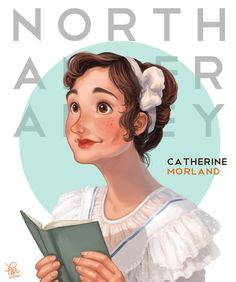Sense & Sensibility, chapter 6: Cottage Core
Life in a Jane Austen novel ain’t always righteous feminine indignation, dances of romances, and triumphs over pompous know-it-alls. Sometimes we have to spend page time getting from one place to another.
But there are a lot of little details that this chapter presents, starting with the unromantic definition of Barton Cottage—which “[a]s a house” is “comfortable and compact; but as a cottage ... defective, for the building was regular, the roof was tiled, the window shutters were not painted green, nor were the walls covered with honeysuckles.” You might think that Marianne, who lately waxed poetic to the Norland trees, would be disappointed in this. But no: “each for the sake of the others [resolve] to appear happy” as they explore the new digs and confer with the servants. This in particular is a theme we’re going to return to—putting on a happy face for the benefit of others—and will emerge as an essential difference between the two sisters.
The change of climate and environment also works on a couple of levels. The open space of the land allows for a great view of the valleys and hills, and the early September weather means that there are still good days for walks before the rainy winter. The Dashwoods’ new world is open to them, but at first seems to be sparsely populated; it’s a blank slate that can invite imaginative impulses or stifle them entirely.
Mama Dashwood’s imagination is already alive with idea of how to improve the cottage, like knocking out a wall here and adding a couple rooms there. Unfortunately, she hasn’t quite processed just how much (or rather, how little) one can stretch 500 pounds a year. Now, had John Dashwood kept the promise he made to his father on his deathbed, maybe Mama Dashwood’s plans for home improvement wouldn’t seem so absurd. And the house feels a mite smaller when you consider that there are 7 inhabitants counting the servants. So Mama Dashwood feeling cramped and hoping to turn the cottage into a mini-Norland, while not practical, is somewhat understandable. She does have “money enough to supply … greater elegance to the apartments” as well, so I guess she’ll be looking at some pieces from Ethan Allen.*
In the meantime, we have a small scene where the Dashwoods act as one, “endeavoring, by placing around them their books and other possessions, to form themselves a home.” The cottage has enough room for Marianne’s pianoforte (one of the few possessions they were allowed to bring), and “Elinor’s drawings [are] affixed to the walls of their sitting room.” Thus both characters still have enough time and resources for their creative pursuits (though whether this is an example of metaphor or just a reflection of reality, I don’t quite know).
But the world must be peopled, and the Dashwoods soon meet its most personable person, their cousin Sir John Middleton. Right away, the difference between he and their other relation named John is stark: the “comfort” of his extended family appears “to be an object of real solicitude to him,” and no sooner does he introduce him than he insists on a) fetching their mail for them, b) introducing them to his wider social circle, and c) inviting them to eat at his place every day while they’re stocking their new pantry (another small irony, as he is happy to give the Dashwoods the kind of supper that John Dashwood thought only suitable as a special occasion**). Sir John is a LOT, which is countered in the straight-laced behavior of his wife, who conveys “a very civil message … denoting her intention of waiting on Mrs. Dashwood,” as is proper. However, her subsequent visit “[shows] that though perfectly well-bred, she was reserved, cold, and had nothing to say for herself beyond the most common-place inquiry or remark.”
Here we establish our motif—or running gag, if you’re not into academic terminology—of opposite pairings. Sir John and Lady Middleton are opposites to the point where it feels like parody, which obviously plays into the comical aspect of this novel and also echoes the title itself. In a broader sense, it creates an expectation of the variety of personalities the Dashwoods will encounter in their new circle—good manners are not proof of intelligence or an indicator of kindness, but kindness doesn’t prevent intrusive or rude behavior. This inconsistency has a tendency to show up in authority figures, which complicates the Dashwood sisters’ journeys.
In the next chapter, we meet a semi-unlikely potential suitor and the ultimate Gossip Girl.
Credit for the above image goes to Sonny Liew, who illustrated the Sense & Sensibility graphic novel by Nancy Butler.
*A little unpatriotic, don’t you think?
**I’d like to point out that I made this connection on my own, but David M. Shapard also observes this in his annotation.



Comments
Post a Comment